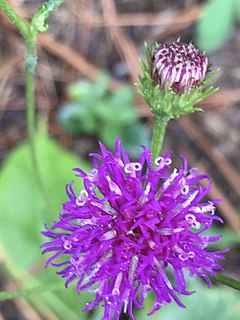
Vernonia is a genus of about 350 species of forbs and shrubs in the family Asteraceae. Some species are known as ironweed. Some species are edible and of economic value. They are known for having intense purple flowers. The genus is named for the English botanist William Vernon. There have been numerous distinct subgenera and subsections named in this genus, and some botanists have divided the genus into several distinct genera. For instance, the Flora of North America recognizes only about twenty species in Vernoniasensu stricto, seventeen of which are in North America north of Mexico, with the others being found in South America.
Colonel Richard Henry Beddome was a British military officer and naturalist in India, who became chief conservator of the Madras Forest Department. In the mid-19th century, he extensively surveyed several remote and then-unexplored hill ranges in Sri Lanka and south India, including those in the Eastern Ghats such as Yelandur, Kollegal, Shevaroy Hills, Yelagiri, Nallamala Hills, Visakhapatnam hills, and the Western Ghats such as Nilgiri hills, Anaimalai hills, Agasthyamalai Hills and Kudremukh. He described many species of plants, amphibians, and reptiles from southern India and Sri Lanka, and several species from this region described by others bear his name.

Psychotria is a genus of flowering plants in the family Rubiaceae. It contains 1,582 species and is therefore one of the largest genera of flowering plants. The genus has a pantropical distribution and members of the genus are small understorey trees in tropical forests. Some species are endangered or facing extinction due to deforestation, especially species of central Africa and the Pacific.

Vernonia cockburniana is a species of flowering plant in the Asteraceae family. It is endemic to Yemen. Its natural habitats are subtropical or tropical dry forests and subtropical or tropical dry shrubland.
Vernonia djalonensis is a critically endangered species of plants in the family Asteraceae. It is native to the West African country of Guinea.

Vernonia acaulis is a species of perennial plant from family Asteraceae. It is native to the U.S.A.
Vernonia actaea is a species of perennial plant in the family Asteraceae. It is endemic to Sulawesi.
Vernonia alleizettei is a species of flowering plant in the aster family, Asteraceae. It is endemic to Madagascar.
Vernonia ampandrandavensis is a species of perennial plant in the family Asteraceae. It is endemic to Madagascar.
Vernonia andapensis is a species of perennial plant in the family Asteraceae. It is endemic to Madagascar.
Vernonia aosteana is a species of perennial plant in the family Asteraceae. It is native to Zimbabwe.
Vernonia brazzavillensis is a species of perennial plant in the family Asteraceae. It is endemic to The Republic of the Congo and the Democratic Republic of Congo.
Vernonia colorata is a species of plant in the family Asteraceae. It is endemic to tropical and southern Africa.
Vernonia dranensis is a species of flowering plant in the family Asteraceae. It is native to Vietnam.
Vernonia flaccidifolia is a species of flowering plant in the family Asteraceae. It is native to Georgia, Tennessee, and Alabama.
Vernonia sechellensis was a species of plant in the daisy family Asteraceae. It has not been seen since its original discovery on the island of Mahé in 1874. It was endemic to the Seychelles.
Vernonia dewildemania is a species of plant in the family Asteraceae. It is native to Zambia and the Democratic Republic of the Congo.

Vernonia angustifolia is a species of flowering plant in the family Asteraceae, native to the southeastern United States. It was first described by André Michaux in 1803.

Acilepis ornata is a species of plant and native to India. The species was first described by William Alexander Talbot in 1898 as Vernonia ornata.





